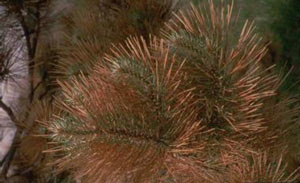Dessication
Dessication - Spring 2013
 Desiccation is a big concern going into the spring of 2013. Desiccation occurs when the requirements for water in trees exceeds the available moisture that is in the soil for the roots to uptake.
Desiccation is a big concern going into the spring of 2013. Desiccation occurs when the requirements for water in trees exceeds the available moisture that is in the soil for the roots to uptake.
Here in central Iowa, we have been seeing dead spruce, arborvitae, white pines, and the like. These species continue to have requirements for water throughout much of the winter season. Desiccation also can affect evergreen species such as boxwood and rhododendron.
Many homeowners are suffering heartbreak over the loss of mature conifers all over the state. Here in central Iowa, we have been seeing dead spruce, arborvitae, white pines, and the like. These species continue to have requirements for water throughout much of the winter season. Desiccation occurs when the requirements for water in these trees exceeds the available moisture that is in the soil for the roots to uptake.
Symptoms of this environmental damage may show up as general off color needles, brown tips on needles, and can be as severe as to cause death of the tree. Desiccation also can affect evergreen species such as boxwood and rhododendron. The evergreen leaves on these species may look white to brown, and may also lead to the death of the plant.
Before diagnosis, look at the surrounding site conditions of the plant. Is the plant protected from prevailing winter wind patterns? Is the plant mulched? Compare to surrounding plants on the site, desiccation generally affects an entire group of plantings, not a single specimen within a group. Be sure to ask your client about maintenance practices, did the tree receive any supplemental watering last fall? If you are planting a replacement, you should consider the above factors when making species and placement decisions.
Prevention is the best medicine for this problem. All arborist standards pertaining to mulch, pruning, site selection, etc should be observed throughout the growing season. As a general rule, all trees and shrubs should receive the equivalent of 1” of water per week. Maintaining soil moisture is especially important to the conifers and evergreens because they essentially have a longer growing season.

According the US Drought Monitor, Polk County is under a severe drought, with a large area just north and west of here under an extreme drought. A small area in extreme southeastern Iowa is the only portion of the state with adequate soil moisture. The US drought monitoring map can be found on the NOAA website. Arborists should continue to monitor soil moisture levels in their area to enable better understanding of plant
requirements. For now you will likely choose to recommend that your clients get some water on their evergreens or conifers if they appear to be struggling, you may even be recommending removing and replacing many.
Photos courtesy of Mike Schomaker, Colorado State Forest Service, Bugwood.org, and USDA Forest Service - Region 2 - Rocky Mountain Region Archive, USDA Forest Service, Bugwood.org.
Melinda “Mindy” Charron ISA Certified Arborist #MW-4872A